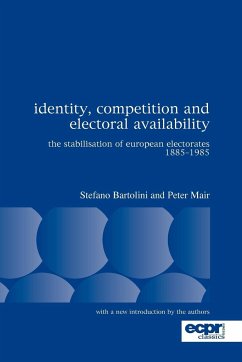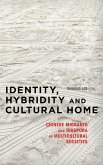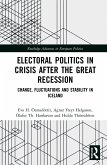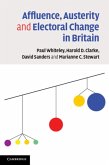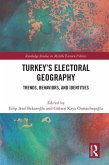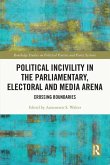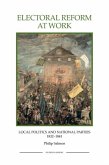Stefano Bartolini, Peter Mair
Identity, Competition and Electoral Availability
The Stabilisation of European Electorates 1885-1985
Stefano Bartolini, Peter Mair
Identity, Competition and Electoral Availability
The Stabilisation of European Electorates 1885-1985
- Broschiertes Buch
- Merkliste
- Auf die Merkliste
- Bewerten Bewerten
- Teilen
- Produkt teilen
- Produkterinnerung
- Produkterinnerung
The authors examine patterns of electoral persistence and change in Western Europe between 1885 and 1985.
Andere Kunden interessierten sich auch für
![Identity, Hybridity and Cultural Home Identity, Hybridity and Cultural Home]() Shuang LiuIdentity, Hybridity and Cultural Home185,99 €
Shuang LiuIdentity, Hybridity and Cultural Home185,99 €![Electoral Politics in Crisis After the Great Recession Electoral Politics in Crisis After the Great Recession]() Eva H. Onnudottir (Iceland. University of Iceland)Electoral Politics in Crisis After the Great Recession63,99 €
Eva H. Onnudottir (Iceland. University of Iceland)Electoral Politics in Crisis After the Great Recession63,99 €![Affluence, Austerity and Electoral Change in Britain Affluence, Austerity and Electoral Change in Britain]() Paul WhiteleyAffluence, Austerity and Electoral Change in Britain36,99 €
Paul WhiteleyAffluence, Austerity and Electoral Change in Britain36,99 €![Turkey's Electoral Geography Turkey's Electoral Geography]() Turkey's Electoral Geography40,99 €
Turkey's Electoral Geography40,99 €![Political Incivility in the Parliamentary, Electoral and Media Arena Political Incivility in the Parliamentary, Electoral and Media Arena]() Political Incivility in the Parliamentary, Electoral and Media Arena40,99 €
Political Incivility in the Parliamentary, Electoral and Media Arena40,99 €![Electoral Reform at Work Electoral Reform at Work]() Philip SalmonElectoral Reform at Work43,99 €
Philip SalmonElectoral Reform at Work43,99 €![Electoral Reform and National Security in Japan Electoral Reform and National Security in Japan]() Amy Catalinac (Canberra Australian National University)Electoral Reform and National Security in Japan25,99 €
Amy Catalinac (Canberra Australian National University)Electoral Reform and National Security in Japan25,99 €-
-
-
The authors examine patterns of electoral persistence and change in Western Europe between 1885 and 1985.
Hinweis: Dieser Artikel kann nur an eine deutsche Lieferadresse ausgeliefert werden.
Hinweis: Dieser Artikel kann nur an eine deutsche Lieferadresse ausgeliefert werden.
Produktdetails
- Produktdetails
- Verlag: Rowman & Littlefield International
- Seitenzahl: 346
- Erscheinungstermin: 1. September 2007
- Englisch
- Abmessung: 234mm x 156mm x 19mm
- Gewicht: 536g
- ISBN-13: 9780955248832
- ISBN-10: 0955248833
- Artikelnr.: 23515830
- Herstellerkennzeichnung
- Libri GmbH
- Europaallee 1
- 36244 Bad Hersfeld
- gpsr@libri.de
- Verlag: Rowman & Littlefield International
- Seitenzahl: 346
- Erscheinungstermin: 1. September 2007
- Englisch
- Abmessung: 234mm x 156mm x 19mm
- Gewicht: 536g
- ISBN-13: 9780955248832
- ISBN-10: 0955248833
- Artikelnr.: 23515830
- Herstellerkennzeichnung
- Libri GmbH
- Europaallee 1
- 36244 Bad Hersfeld
- gpsr@libri.de
By Stefano Bartolini and Peter Mair
New introduction by the authors 1 Preface and acknowledgments 7 Introduction 11 PART ONE FRAMEWORK 25 Chapter one: Understanding electoral instability 27 The measures 28 Concepts and indices 31 Aggregate volatility as a system property 33 Aggregate volatility and individual voting shifts 34 Theoretical variants 40 A general framework for analysis 42 PART TWO THE STABILISATION OF EUROPEAN ELECTORATES 57 Chapter two: Interpreting electoral change: a debate 59 The evidence of aggregate data 62 Parties and cleavages 65 Chapter three: The bias towards stability 70 Variance in electoral instability 70 Variance in class
cleavage volatility 76 The relationship between cleavage volatility and total volatility 83 Types of elections and cleavages 85 Chapter four: Electoral instability and class
cleavage persistence 1885
1985 96 Testing the freezing hypothesis 96 The salience of the class cleavage 103 A general stabilisation? 105 National variations 106 Trends over time: a summary 117 PART THREE THE DETERMINANTS OF ELECTORAL INSTABILITY 123 Introduction 125 Chapter five: The fragmentation of party systems 127 Which parties count? 128 Trends in fragmentation 129 Numbers of parties and electoral volatility 131 National variations 134 Chapter six: Institutional constraints and voter opportunities 141 The impact of enfranchisement 142 Voting systems and electoral instability 145 Change of electoral systems 146 Majoritarianism versus proportionality 149 From dichotomised to continuous variables 152 Indicators of disproportionality 154 Disproportionality and volatility 155 Cross
national variation 158 Institutional constraints and electoral instability 160 Chapter seven: Electoral participation 165 When turnout matters 166 Turnout increase 167 Turnout decline 168 Variation between countries 172 Electoral participation and volatility 175 Format, institutional change, and participation 176 Chapter eight: The space of competition 182 The extent of electoral elasticity 182 Spatial competition and electoral instability 184 An interpretation of negative findings 189 Another test of the spatial hypothesis 191 National variations 193 Space and segmentation 196 Chapter nine: Cleavage systems 198 The concept of cleavage 199 Social homogeneity versus closure of mobility 205 Empirical evidence 209 The dimension of cultural heterogeneity 210 The organisational dimension 214 Cultural heterogeneity and organisational density 220 Segmentation and electoral instability 223 PART FOUR COMPETITION AND IDENTITY 231 Chapter ten: Explaining electoral instability 233 The overall pattern 234 Electoral phases 240 Cross
national variation 244 Refining the model: spatial, organisational, and cultural factors 248 A parsimonious model 255 Chapter eleven: Socio
organisational bonds, institutional incentives, and political markets 261 The stabilisation of voting patterns 262 From competition to identity 263 The forces shaping electoral mobility 266 Some applications: polarised pluralism and consociational democracy 271 Towards destabilisation? 274 Appendices and data
base 1 Rules for calculation and notes on sources 281 2 Party volatilities: data
base 291 Index 319
cleavage volatility 76 The relationship between cleavage volatility and total volatility 83 Types of elections and cleavages 85 Chapter four: Electoral instability and class
cleavage persistence 1885
1985 96 Testing the freezing hypothesis 96 The salience of the class cleavage 103 A general stabilisation? 105 National variations 106 Trends over time: a summary 117 PART THREE THE DETERMINANTS OF ELECTORAL INSTABILITY 123 Introduction 125 Chapter five: The fragmentation of party systems 127 Which parties count? 128 Trends in fragmentation 129 Numbers of parties and electoral volatility 131 National variations 134 Chapter six: Institutional constraints and voter opportunities 141 The impact of enfranchisement 142 Voting systems and electoral instability 145 Change of electoral systems 146 Majoritarianism versus proportionality 149 From dichotomised to continuous variables 152 Indicators of disproportionality 154 Disproportionality and volatility 155 Cross
national variation 158 Institutional constraints and electoral instability 160 Chapter seven: Electoral participation 165 When turnout matters 166 Turnout increase 167 Turnout decline 168 Variation between countries 172 Electoral participation and volatility 175 Format, institutional change, and participation 176 Chapter eight: The space of competition 182 The extent of electoral elasticity 182 Spatial competition and electoral instability 184 An interpretation of negative findings 189 Another test of the spatial hypothesis 191 National variations 193 Space and segmentation 196 Chapter nine: Cleavage systems 198 The concept of cleavage 199 Social homogeneity versus closure of mobility 205 Empirical evidence 209 The dimension of cultural heterogeneity 210 The organisational dimension 214 Cultural heterogeneity and organisational density 220 Segmentation and electoral instability 223 PART FOUR COMPETITION AND IDENTITY 231 Chapter ten: Explaining electoral instability 233 The overall pattern 234 Electoral phases 240 Cross
national variation 244 Refining the model: spatial, organisational, and cultural factors 248 A parsimonious model 255 Chapter eleven: Socio
organisational bonds, institutional incentives, and political markets 261 The stabilisation of voting patterns 262 From competition to identity 263 The forces shaping electoral mobility 266 Some applications: polarised pluralism and consociational democracy 271 Towards destabilisation? 274 Appendices and data
base 1 Rules for calculation and notes on sources 281 2 Party volatilities: data
base 291 Index 319
New introduction by the authors 1 Preface and acknowledgments 7 Introduction 11 PART ONE FRAMEWORK 25 Chapter one: Understanding electoral instability 27 The measures 28 Concepts and indices 31 Aggregate volatility as a system property 33 Aggregate volatility and individual voting shifts 34 Theoretical variants 40 A general framework for analysis 42 PART TWO THE STABILISATION OF EUROPEAN ELECTORATES 57 Chapter two: Interpreting electoral change: a debate 59 The evidence of aggregate data 62 Parties and cleavages 65 Chapter three: The bias towards stability 70 Variance in electoral instability 70 Variance in class
cleavage volatility 76 The relationship between cleavage volatility and total volatility 83 Types of elections and cleavages 85 Chapter four: Electoral instability and class
cleavage persistence 1885
1985 96 Testing the freezing hypothesis 96 The salience of the class cleavage 103 A general stabilisation? 105 National variations 106 Trends over time: a summary 117 PART THREE THE DETERMINANTS OF ELECTORAL INSTABILITY 123 Introduction 125 Chapter five: The fragmentation of party systems 127 Which parties count? 128 Trends in fragmentation 129 Numbers of parties and electoral volatility 131 National variations 134 Chapter six: Institutional constraints and voter opportunities 141 The impact of enfranchisement 142 Voting systems and electoral instability 145 Change of electoral systems 146 Majoritarianism versus proportionality 149 From dichotomised to continuous variables 152 Indicators of disproportionality 154 Disproportionality and volatility 155 Cross
national variation 158 Institutional constraints and electoral instability 160 Chapter seven: Electoral participation 165 When turnout matters 166 Turnout increase 167 Turnout decline 168 Variation between countries 172 Electoral participation and volatility 175 Format, institutional change, and participation 176 Chapter eight: The space of competition 182 The extent of electoral elasticity 182 Spatial competition and electoral instability 184 An interpretation of negative findings 189 Another test of the spatial hypothesis 191 National variations 193 Space and segmentation 196 Chapter nine: Cleavage systems 198 The concept of cleavage 199 Social homogeneity versus closure of mobility 205 Empirical evidence 209 The dimension of cultural heterogeneity 210 The organisational dimension 214 Cultural heterogeneity and organisational density 220 Segmentation and electoral instability 223 PART FOUR COMPETITION AND IDENTITY 231 Chapter ten: Explaining electoral instability 233 The overall pattern 234 Electoral phases 240 Cross
national variation 244 Refining the model: spatial, organisational, and cultural factors 248 A parsimonious model 255 Chapter eleven: Socio
organisational bonds, institutional incentives, and political markets 261 The stabilisation of voting patterns 262 From competition to identity 263 The forces shaping electoral mobility 266 Some applications: polarised pluralism and consociational democracy 271 Towards destabilisation? 274 Appendices and data
base 1 Rules for calculation and notes on sources 281 2 Party volatilities: data
base 291 Index 319
cleavage volatility 76 The relationship between cleavage volatility and total volatility 83 Types of elections and cleavages 85 Chapter four: Electoral instability and class
cleavage persistence 1885
1985 96 Testing the freezing hypothesis 96 The salience of the class cleavage 103 A general stabilisation? 105 National variations 106 Trends over time: a summary 117 PART THREE THE DETERMINANTS OF ELECTORAL INSTABILITY 123 Introduction 125 Chapter five: The fragmentation of party systems 127 Which parties count? 128 Trends in fragmentation 129 Numbers of parties and electoral volatility 131 National variations 134 Chapter six: Institutional constraints and voter opportunities 141 The impact of enfranchisement 142 Voting systems and electoral instability 145 Change of electoral systems 146 Majoritarianism versus proportionality 149 From dichotomised to continuous variables 152 Indicators of disproportionality 154 Disproportionality and volatility 155 Cross
national variation 158 Institutional constraints and electoral instability 160 Chapter seven: Electoral participation 165 When turnout matters 166 Turnout increase 167 Turnout decline 168 Variation between countries 172 Electoral participation and volatility 175 Format, institutional change, and participation 176 Chapter eight: The space of competition 182 The extent of electoral elasticity 182 Spatial competition and electoral instability 184 An interpretation of negative findings 189 Another test of the spatial hypothesis 191 National variations 193 Space and segmentation 196 Chapter nine: Cleavage systems 198 The concept of cleavage 199 Social homogeneity versus closure of mobility 205 Empirical evidence 209 The dimension of cultural heterogeneity 210 The organisational dimension 214 Cultural heterogeneity and organisational density 220 Segmentation and electoral instability 223 PART FOUR COMPETITION AND IDENTITY 231 Chapter ten: Explaining electoral instability 233 The overall pattern 234 Electoral phases 240 Cross
national variation 244 Refining the model: spatial, organisational, and cultural factors 248 A parsimonious model 255 Chapter eleven: Socio
organisational bonds, institutional incentives, and political markets 261 The stabilisation of voting patterns 262 From competition to identity 263 The forces shaping electoral mobility 266 Some applications: polarised pluralism and consociational democracy 271 Towards destabilisation? 274 Appendices and data
base 1 Rules for calculation and notes on sources 281 2 Party volatilities: data
base 291 Index 319

